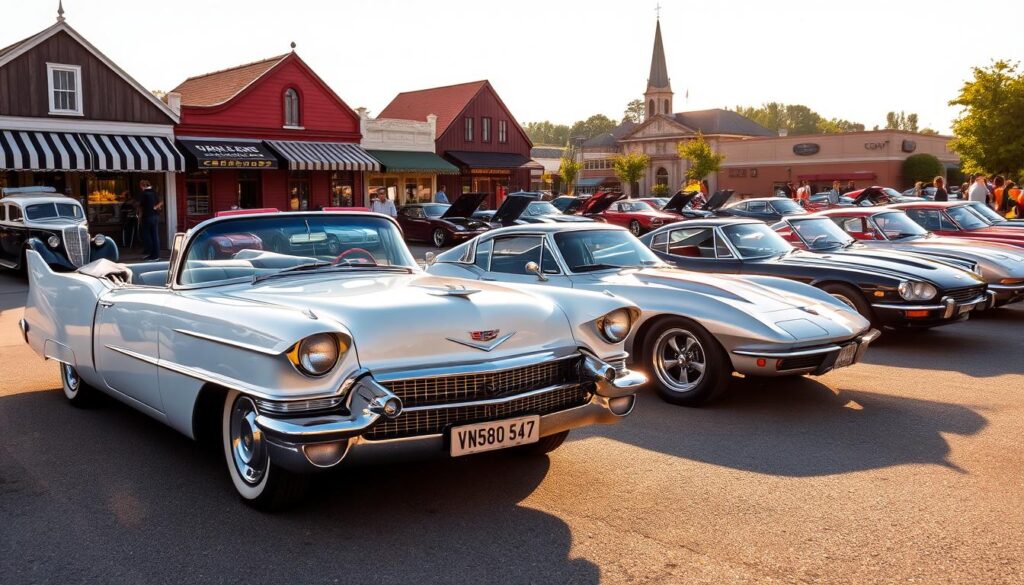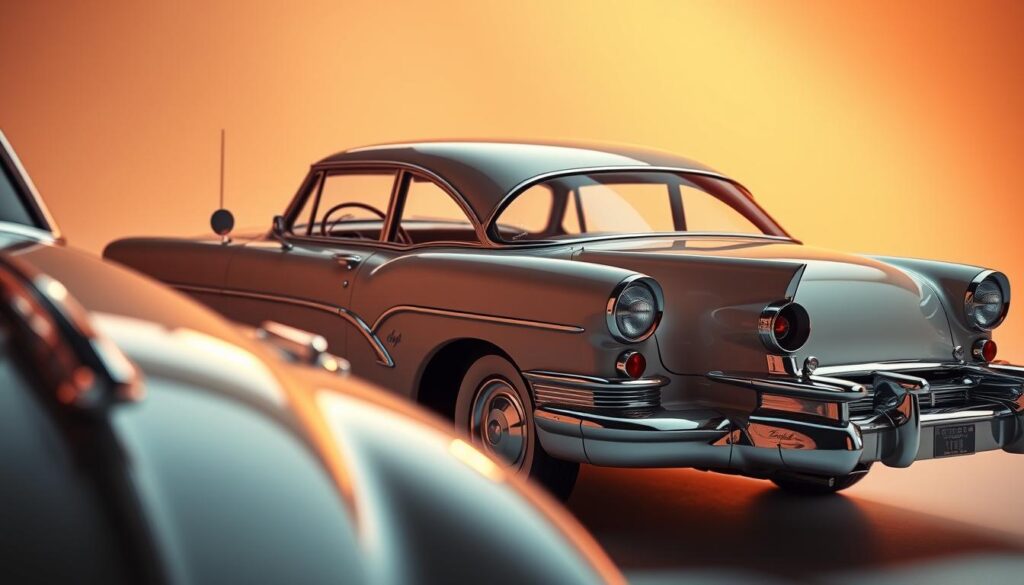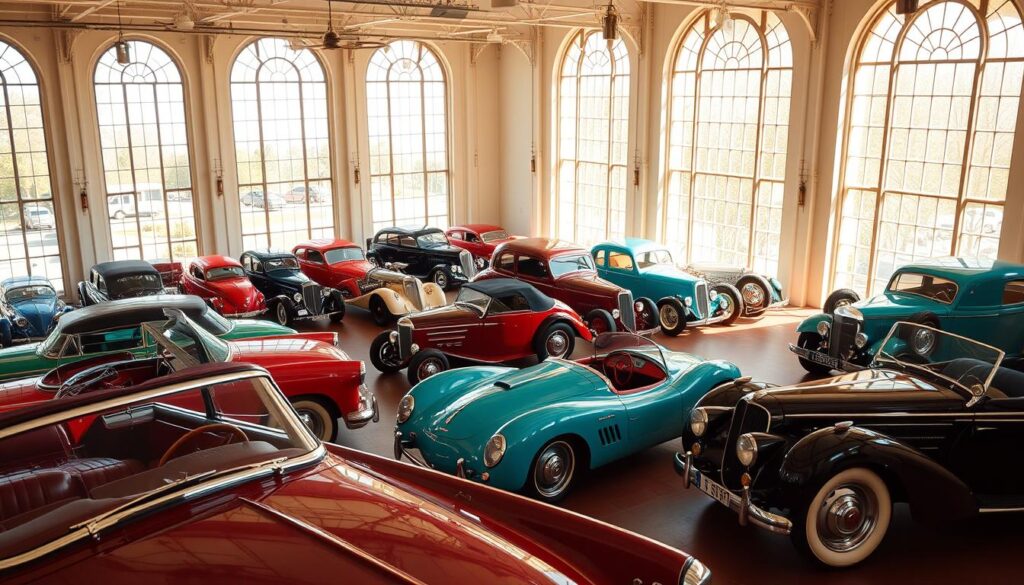Have you ever been drawn to the beauty and charm of vintage classic cars? These cars bring a sense of history and elegance. They capture the hearts of car lovers everywhere.

The beauty of a classic automobile goes beyond its looks. It’s about the feelings it brings up. Owning or admiring these cars is like taking a trip back in time. It connects you to the past.Vintage Classic Cars: Embracing the Elegance of the Past
Let’s dive into the world of vintage classic cars. We’ll look at their history, design, and the special bond they share with their fans. You’ll see why these cars are still loved and admired today.
Key Takeaways
- Understanding the appeal of vintage classic cars
- Exploring the history and design of classic automobiles
- The emotional connection between classic cars and their enthusiasts
- Why vintage classic cars continue to captivate audiences today
- The significance of preserving classic automobiles for future generations
The Timeless Appeal of Vintage Classic Cars
Vintage classic cars have a unique charm with their sleek designs and rich history. They are more than just cars; they are pieces of art that show the automotive history of their time.
Defining What Makes a Car “Vintage” and “Classic”
The terms “vintage” and “classic” are often mixed up, but they mean different things. A vintage car is usually between 30 and 45 years old. A classic car is at least 25 years old and has historical or aesthetic value. Knowing these definitions helps us appreciate these cars’ unique qualities.
The Emotional Connection to Automotive History
Vintage classic cars connect us to the past, showing a time of elegance and sophistication. A famous car collector once said,
“Classic cars are not just machines; they are a connection to our history, a reminder of the craftsmanship and innovation that defined an era.”
This emotional tie is why they remain popular. They let owners and fans relive memories and enjoy the joy of automotive history. Vintage Classic Cars: Embracing the Elegance of the Past.
For many, owning a vintage classic car is a way to keep history alive and share it with others. The bond with these cars is personal, showing a love for the art and skill that goes into making them.
The Golden Eras of Automotive Design
Exploring vintage classic cars reveals special periods known for their groundbreaking designs. The history of car design is a tale of growth, with each era adding its own flair and tech to classic cars.

Pre-War Classics (1910s-1930s)
The pre-war era was when car design began, with cars becoming more common and styles evolving. The 1928 Ford Model A shows how cars moved from simple transport to stylish goods. These early classics still wow fans and collectors today.
Post-War Revolution (1940s-1950s)
After World War II, car design and tech saw a big leap forward. The post-war era was filled with hope and a push for new ideas. Cars like the 1955 Chevrolet Bel Air became symbols of American success and energy.
Muscle Car Era (1960s-1970s)
The muscle car era focused on speed and style, with cars that were both fast and good-looking. The 1969 Ford Mustang Mach 1 is a perfect example, mixing bold looks with strong engines. This era is loved for its mix of beauty and power.
These eras have woven a rich history of car design, inspiring fans worldwide. As you explore classic cars, learning about these eras deepens your love for their design and history.
Iconic Vintage Classic Cars That Defined Generations
Vintage classic cars are loved for their unique looks, history, and stories. They are key parts of car history, drawing fans and collectors.
American Legends
American classic cars are known for their power, style, and new ideas. Famous brands have made them symbols of American car culture.
Ford Mustang and Thunderbird
The Ford Mustang is famous for its sleek look and strong engine. The Thunderbird is loved for its luxury and special design.
Chevrolet Corvette and Bel Air
The Chevrolet Corvette is a top American sports car, known for its speed. The Bel Air shows the best of 1950s American car design, with its chrome and elegant lines.
Cadillac Eldorado and DeVille
The Cadillac Eldorado is a luxury car with advanced tech and fancy interiors. The DeVille series is known for its comfort, style, and strong performance.
European Masterpieces
European classic cars are loved for their smart design, top engineering, and racing history. They show the elegance and power of European car culture.
Jaguar E-Type and Mark2
The Jaguar E-Type is known for its beauty and great performance, making it a top classic car. The Mark2 is valued for its sleek look and strong performance.
Mercedes-Benz 300SL and 190SL
The Mercedes-Benz 300SL is famous for its gull-wing doors and racing success. The 190SL is loved for its stylish design and fun drive.
Ferrari 250 GT and Dino
The Ferrari 250 GT is a rare collector’s item, known for its racing wins and beautiful design. The Dino is admired for its new design and Ferrari’s junior line legacy.
Rare Gems Worth Seeking
When collecting cars, people often look for rare and unique models. These stand out from common vintage classics.
| Model | Year | Notable Features |
|---|---|---|
| Aston Martin DB4 | 1958-1963 | Sleek design, powerful engine |
| Porsche 356 | 1948-1965 | Lightweight, agile, and a strong racing heritage |
| Alfa Romeo Giulietta | 1954-1962 | Elegant design, responsive handling |
The Art of Collecting Vintage Automobiles
Starting a vintage car collection is a mix of passion, knowledge, and patience. It’s more than just buying old cars. It’s about keeping history alive and admiring the skill of the past.

Starting Your Collection: What to Look For
When you start, know what to look for. Check the car’s condition, how rare it is, and its historical importance. Learning about the market and the value of models helps you make smart choices.
Authentication and Documentation
Checking a car’s authenticity and history is key. Look for cars with clear histories, like maintenance records and restoration documents. This boosts the car’s value and proves it’s real.
Building Relationships in the Collector Community
Connecting with other collectors makes collecting better. Go to car shows, join clubs, and use online forums. These connections offer insights, help find new cars, and create a sense of community.
By focusing on these points, you’ll build an amazing vintage car collection. It will show your passion and dedication to collecting.
Experiencing the Joy of Vintage Classic Cars
Driving a vintage classic car is a special experience. It connects you to the elegance and craftsmanship of the past. For many, owning and driving a vintage car is a dream come true.
The Unique Driving Experience
Driving a vintage classic car is unlike any other experience. It’s not just driving; it’s immersing yourself in history. The feel of a manual transmission and mechanical systems makes driving more engaging than modern cars.
- The sound of the engine roaring to life
- The feel of the gearshift in your hand
- The sight of the vintage dashboard and instruments
These elements make driving a vintage car both nostalgic and exhilarating. Every drive is a memorable event.Vintage Classic Cars: Embracing the Elegance of the Past
Participating in Shows and Rallies
Vintage classic car owners love to show off their cars at car shows and rallies. These events celebrate the rich history of vintage cars. They offer a chance to display your car, share your passion, and meet other enthusiasts.
- Car shows let you show off your vintage car with other classics
- Rallies let you drive your car with others, enjoying scenic routes and camaraderie
Being part of these events is rewarding. You get to show off your car’s beauty and craftsmanship.
Sharing Your Passion with Others
Owning a vintage classic car brings people together. You can share your passion online, in local car clubs, and at social events. This way, you enhance your experience and help preserve automotive history.
Sharing stories and advice with others deepens your appreciation for vintage cars. It creates lasting friendships and memories.
Maintaining and Preserving Automotive History
Keeping automotive history alive is a delicate task. It involves making smart choices about restoration and upkeep. As a collector, you’re not just fixing a car. You’re also saving a piece of history that needs to be loved.
Preservation vs. Restoration Approaches
Choosing between preservation and restoration for your classic automobile is key. Preservation keeps the car as it is, while restoration tries to make it like new again. Your choice depends on what you want and the car’s importance in history.
Finding Specialized Parts and Services
Finding the right parts and services for your vintage car can be tough. You might need to look for specialized suppliers or join collector groups. This network can be very helpful in keeping your classic automobile true to its roots.Vintage Classic Cars: Embracing the Elegance of the Past
Proper Storage and Maintenance Routines
Regular care is essential to keep your vintage car in top shape. This includes storing it in a climate-controlled area and checking it often. By following these steps, you can keep your classic automobile looking great for many years.Vintage Classic Cars: Embracing the Elegance of the Past
Conclusion: Keeping the Legacy of Classic Automobiles Alive
Exploring vintage classic cars makes you part of a special community. These cars are more than just vehicles. They are art that brings joy and creates memories.
Whether you love collecting or just enjoy these cars, their charm is unique. By loving and caring for them, you help keep their history alive.
Keep the legacy alive by going to car shows, joining clubs, or just driving your car. You’ll feel the elegance of the past. And you’ll help celebrate the beauty of vintage classic cars.
FAQ
What defines a vintage classic car?
A vintage classic car is usually over 25 years old. It must have historical interest, look great, or have new tech. The exact age can vary by country, but it’s about cars that capture the past’s charm.
How do I start collecting vintage classic cars?
Start by learning about different models, their history, and value. Go to car shows, join forums, and talk to collectors. Think about the car’s condition, how rare it is, and its history when choosing one.
What are the most significant eras for vintage classic cars?
Key eras include the pre-war (1910s-1930s), post-war (1940s-1950s), and muscle car (1960s-1970s) periods. These times brought iconic models, new designs, and big tech leaps that still excite car fans.
How do I maintain and preserve my vintage classic car?
Keep your car in a dry, cool place and check it often. Look at the engine, brakes, and more. Use specialized mechanics and restorers for vintage cars.Vintage Classic Cars: Embracing the Elegance of the Past.
Can I drive my vintage classic car regularly?
You can drive it, but think about safety, upkeep, and insurance. Be ready for possible breakdowns or accidents. Some drive theirs to shows or rallies to enjoy and keep it in good shape.
How do I authenticate the history and provenance of a vintage classic car?
Check maintenance records, ownership history, and restoration papers. Talk to classic car experts for advice on verifying the car’s authenticity and worth.Vintage Classic Cars: Embracing the Elegance of the Past
What are some rare and valuable vintage classic cars to look for?
Look for rare models like the Ferrari 250 GTO or Jaguar E-Type. Also, find cars with interesting histories or famous owners. Check online, auctions, and dealerships for these treasures.


